#chondrules
Text
Currently working on meteorite based patterns — this one's on barred olivine chondrules, a constituent of stony or chondritic meteorites. Chondrites are the oldest unaltered rocks in our solar system, and contain some of the earliest materials to have condensed from the early solar nebula (chondrules, CAIs). Some even contain presolar grains which come from interstellar sources.
Chondrules are flash heated silicate grains with igneous textures. Of these, barred olivine chondrules are arguably the prettiest, exhibiting a form of skeletal growth (which in turn indicates a large degree of supercooling).

Some reference examples (how pretty!):
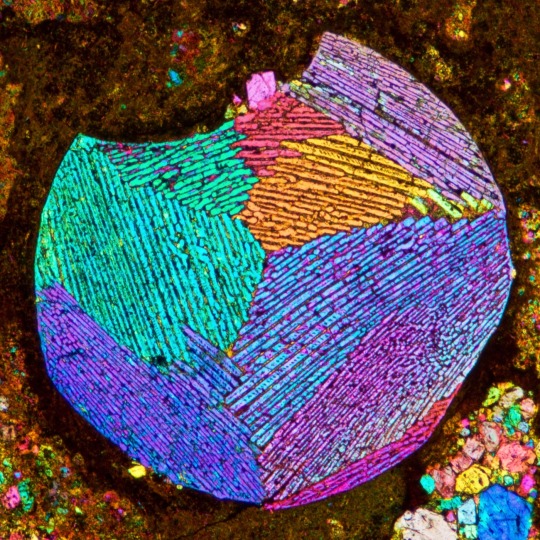


170 notes
·
View notes
Photo
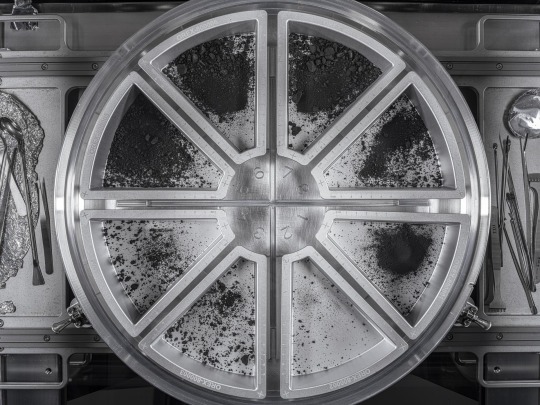


The Bennu samples have rocks unlike any meteorite ever found
... Today, planetary scientists can study not only rocks that have fallen from the sky — they have begun to look for chondrules in materials directly sampled from asteroids to learn more. Most recently, researchers have started analyzing materials returned from asteroid 101955 Bennu, and presented their initial findings at the Lunar and Planetary Science Conference in The Woodlands, Texas, earlier this year.
So far, researchers have not found anything in Bennu samples that looks exactly like chondrules seen in meteorites. But they have found an array of rocks that resemble chondrules to varying degrees, suggesting that asteroids are more diverse than meteorites might suggest. ...
4 notes
·
View notes
Text
What types of meteorites are commonly used in creating meteorite jewelry?


The possibilities for jewelry made from meteorites are as endless as the universe itself. Imagine wearing a gorgeous iron meteorite ring that has been polished to reflect light and display beautiful designs that have been carved out over billions of years.

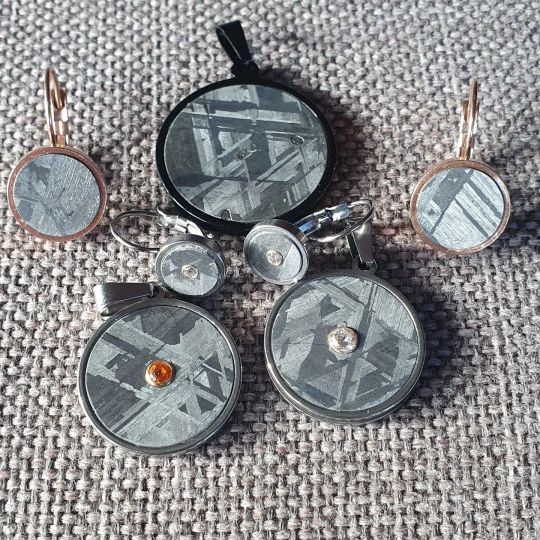
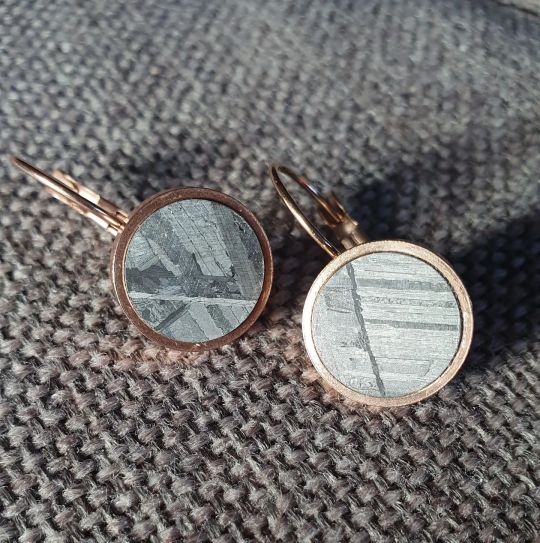
Or perhaps you favor the stony meteorites' ethereal beauty. These meteorites give the jewelry made from them a captivating texture thanks to their chondrules, which are small spherical structures developed in the early solar system.
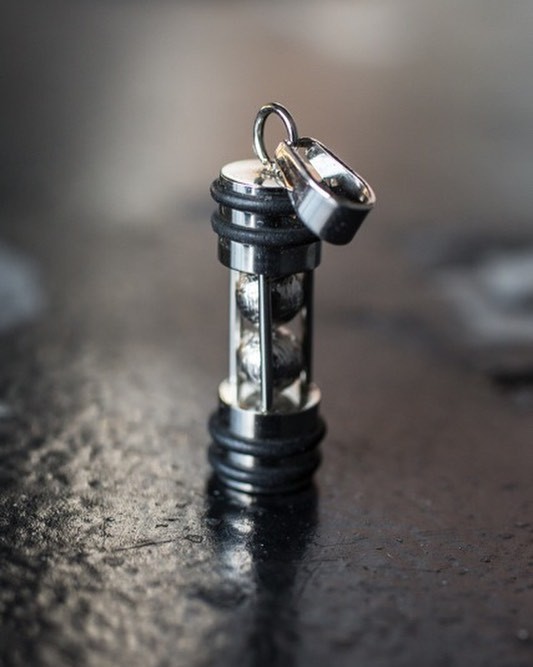
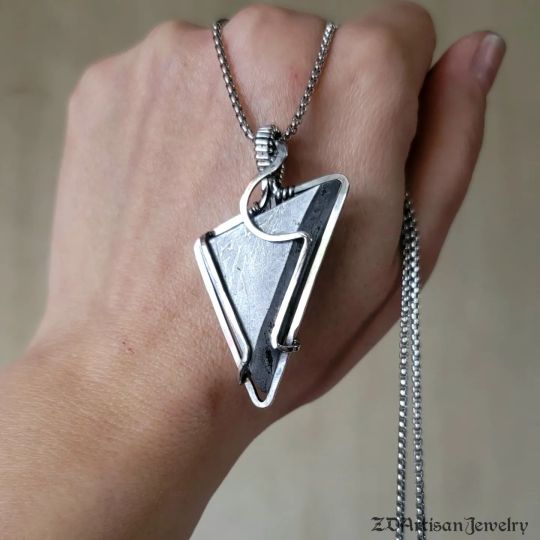


Pallasites, or stony-iron meteorites, offer a really enthralling experience for those looking for a mellow fusion of elegance and cosmic intrigue. Imagine yourself wearing earrings with olivine crystals that sparkle subtly set in an iron-nickel matrix.
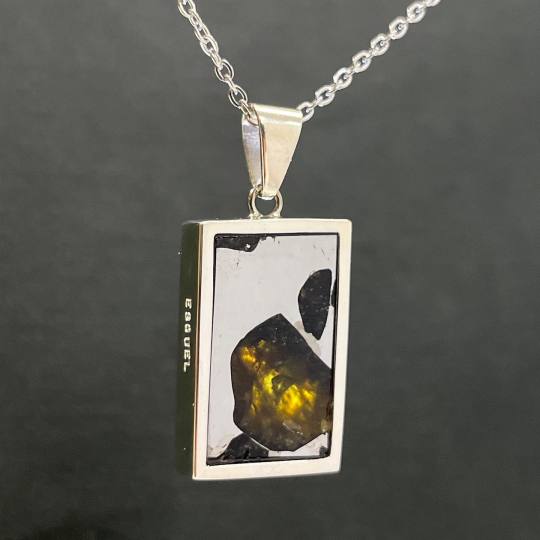
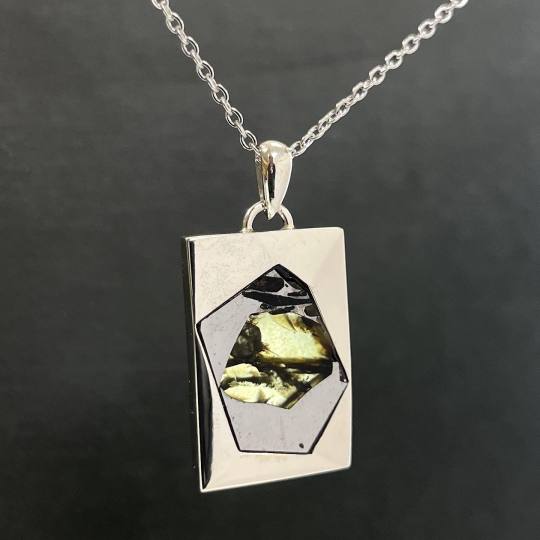
The wearer is connected to the immensity of space and time by the individual narratives that each piece of meteorite jewelry tells. It is an experience that is more than just ornamentation; it is a physical link to the cosmos and a reminder of our presence in it.

Meteorite jewelry offers a unique experience that goes above and beyond regular accessories, whether you're drawn to the gleaming beauty of iron meteorites, the textural allure of stony meteorites, or the intriguing blend of stony-iron meteorites.
0 notes
Text
rdɪtʃtʌərənɪləɪŋeɪnpə
Pronounced: rditshtuuhruhniluhingeinpuh.
Pantheon of: popularity, orientalism, mixture, intractability, fluid, piquancy, worth, here, difference.
Entities
Mtðaʊldʒtbsnttnpiznəsə
Pronounced: mtthowljtbsnttnpiznuhsuh
Intractability: stubbornness.
Difference: discrepancy.
Worth: price.
Mixture: alloy.
Fluid: liquid.
Popularity: hot stuff.
Legends: school assignment, pickup, runup, repositioning.
Prophecies: pure absence, close-quarter fighting, gratification.
Nənrɪɒðrtʃæuʌɛrðtəlui
Pronounced: nuhnriouthrtshauuayrthtuhlui
Intractability: stubbornness.
Difference: otherness.
Worth: merit.
Mixture: solution.
Fluid: liquid.
Popularity: hot stuff.
Legends: renunciation, obscenity, unwritten law, trade.
Prophecies: board game, retaliation, choice, three-point turn, fling.
Rðrtʌzərɪbərvʃfmnuhɪ
Pronounced: rthrtuzuhribuhrvshfmnuhi
Intractability: wildness.
Difference: differentia.
Worth: praisworthiness.
Mixture: mechanical mixture.
Fluid: filtrate.
Popularity: hot stuff.
Legends: stealth, affairs.
Prophecies: drip, spoonfeeding, kick in the butt, gunrunning, solicitation.
Relations: ərɛəsfdsszddrəzsəiəŋ (tributyrin), ɪæəsəətɪəaɪrɪlədtɛzzɛ (proportionality).
Ənizɛlðsmzɑtrndrnəæɪ
Pronounced: uhnizaylthsmzahtrndrnuhai
Intractability: wildness.
Difference: inequality.
Worth: price.
Mixture: gummite.
Fluid: filtrate.
Popularity: hot stuff.
Legends: crowd control.
Prophecies: breach of duty, retake.
Relations: mtðaʊldʒtbsnttnpiznəsə (shellac), ɪæəsəətɪəaɪrɪlədtɛzzɛ (reflexive pronoun), ərɛəsfdsszddrəzsəiəŋ (wiesenboden), nənrɪɒðrtʃæuʌɛrðtəlui (shag).
Ərɛəsfdsszddrəzsəiəŋ
Pronounced: uhrayuhsfdsszddruhzsuhiuhng
Intractability: balkiness.
Difference: discrepancy.
Worth: value.
Mixture: freezing mixture.
Fluid: coolant.
Popularity: hot stuff.
Legends: abnegation, pushball, act, sharing, dip.
Prophecies: battering, enhancement, reverse, request.
Ətlikeədtʃʌɛwtɑnəkown
Pronounced: uhtlikeuhdtshuaywtahnuhkown
Intractability: defiance.
Difference: discrepancy.
Worth: value.
Mixture: colloid.
Fluid: ichor.
Popularity: hot stuff.
Legends: shovel board, start, jumping, digital communications technology, breach of duty.
Prophecies: constriction, foul shot, fatal accident, assent.
Relations: ənizɛlðsmzɑtrndrnəæɪ (shale oil), rðrtʌzərɪbərvʃfmnuhɪ (titanium dioxide), ɪæəsəətɪəaɪrɪlədtɛzzɛ (chondrule), ʌwʌbɑlnaɪnnndɒmməmɪnr (inflection).
Ɪæəsəətɪəaɪrɪlədtɛzzɛ
Pronounced: iauhsuhuhtiuhairiluhdtayzzay
Intractability: wildness.
Difference: differential.
Worth: demerit.
Mixture: soda lime.
Fluid: ichor.
Popularity: hot stuff.
Prophecies: suicide bombing, waste of money, amphibious demonstration, risk, quarantine.
Relations: ənizɛlðsmzɑtrndrnəæɪ (red brass), ʌwʌbɑlnaɪnnndɒmməmɪnr (mileage).
Ʌwʌbɑlnaɪnnndɒmməmɪnr
Pronounced: uwubahlnainnndoummuhminr
Intractability: refractoriness.
Difference: discrepancy.
Worth: worthwhileness.
Mixture: composition.
Fluid: ichor.
Popularity: hot stuff.
Legends: corollary, license.
Relations: ənizɛlðsmzɑtrndrnəæɪ (bitumen), rðrtʌzərɪbərvʃfmnuhɪ (ocher), ətlikeədtʃʌɛwtɑnəkown (reproduction cost), nənrɪɒðrtʃæuʌɛrðtəlui (vichy water).
0 notes
Photo
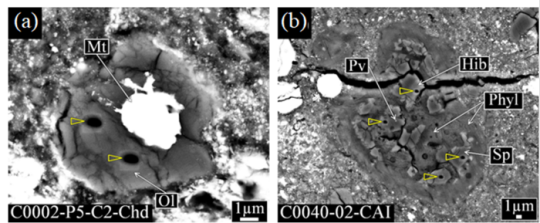

New insights from ancient asteroid Ryugu In June 2018, Japan's Hayabusa2 spacecraft retrieved samples from asteroid Ryugu and successfully returned them to Earth. Researchers at Tohoku University have analysed the samples and identified what they believe may be the oldest solids from the solar system that have thus far become available for study. They reported their findings in the journal Nature Communications on February 16, 2023. The article was also selected to feature in the Editors' Highlights. The work was focused on spherical mineral grains, called chondrule-like objects and calcium-aluminium-rich inclusions (CAIs). These grains are key components of chondritic meteorites, which are delivered to Earth from the asteroid belt without being modified by processes, such as melting, that can affect other meteorites. The samples from Ryugu gave scientists the opportunity to study material freshly gathered from an asteroid that, at the time of sampling, was around 15,000,000 kilometres from Earth. But surprising evidence from the investigations of the samples by many research teams has suggested that Ryugu was initially formed much further from Earth, in the outer reaches of the solar system. A key finding from the analysis by the Tohoku University group is that the grains in the Ryugu samples were likely transported in widening circles from the inner regions of the early solar system out to the much more distant region where the original asteroid Ryugu formed. The team's conclusions are partly based on analysing the ratio of different oxygen isotopes in the samples. These are forms of oxygen atoms with varying masses due to differing numbers of neutrons in their nuclei. The lower mass oxygen-16 isotope has one less neutron than oxygen-17 and two fewer than oxygen-18. Many of the Ryugu grains were enriched in oxygen-16. The isotope content, together with analysis of the grains' sizes and mineral composition, led the researchers to suggest their ancient origin and likely transport outwards to the far regions of the solar system, where they became part of a body that then fragmented to form asteroid Ryugu. "We now want to analyse more of these oldest solar system solids in Ryugu, to try to understand the mechanisms behind the radial transport outwards in the early solar nebula," says geochemist Daisuke Nakashima of the early Solar System Research Group at Tohoku University. Nakashima and colleagues collaborated on the investigation with researchers elsewhere in Japan and the USA. "This is fundamental research into the ancient events that built our solar system," says Nakashima. The work is part of the fascinating process of understanding how the planetary system that eventually gave rise to life on Earth was itself born. TOP IMAGE....Electron microscope images of a chondrule-like object and CAI in the Ryugu samples. CREDIT Tohoku University LOWER IMAGE....Oxygen isotope diagram for the chondrule-like objects and CAIs in the Ryugu samples. CREDIT Nakashima D. et al.
1 note
·
View note
Text
Meteorites and tektites
David Bryant (UK)
The Solar System formed around five billion years ago from a cloud of dust and debris orbiting the Sun. By a process of accretion and remelting by electrical discharges within the dust cloud, this material condensed into spherical particles called chondrules. By collision, the chondrules fused together to form larger and larger planetesimals and these aggregated to form…

View On WordPress
0 notes
Text
Meteorite rock types

Also, I have had some heavily weathered stone meteorites that leave a slight gray streak so be sure you streak a sample representative of the interior.
Rocks with MgO/Fe2O3(T) 6 are probably not meteorites.
The ratio of magnesium to iron does not vary greatly among most kinds of stony meteorites. Also found as a minor mineral in Type 3 ordinary chondrites. contains large amounts of iron and nickel and are often magnetic. High-Fe2O3 meteorwrongs are iron ores, often hematite concretions. Approximately 4,000 minerals have been identified. They include samples of anorthositic breccias from the lunar highlands and basaltic breccias and rocks from the mare regions, i.e. The lunar meteorites are the only group of meteorites for which the source body has been identified unequivocally. Note: Samples passing this test are not necessarily meteorites. Low-MgO rocks are rich in quartz, calcite, or hematite. Jones, in Encyclopedia of Physical Science and Technology (Third Edition), 2003 IX.B Lunar Meteorites. Similarly, the weathering of Earth rocks can make some resemble meteorites. Because they contain some of the same mineralogy - plagioclase, pyroxene, olivine, etc., weathering can cause most that have been here for a while to look like Earth rocks. (the heavy rectangular lid on top of the tank) It is very heavy, so be careful. Meteorites are 'rocks', not from Earth, but from somewhere else in the solar system. You can also use the inside of your toilet tank cover. If a meteor survives its passage through the atmosphere and strikes the Earths surface, it is called a meteorite. You say that you don't have a ceramic tile? You can use the bottom of an ceramic coffee cup or The fragments left of the space rock show that it was an iron meteorite. The impact blasted a hole 1 kilometer (.6 miles) wide and about 230 meters (750 feet) deep. A stone meteorite, unless it is very heavily weathered will not normally leave a streak on the tile. There, more than 50,000 years ago, a meteorite weighing about 270,000 metric tons (300,000 tons) slammed into the Earth with the force of 2.5 million tons of TNT. If it leaves a black/gray streak (like a soft leaded pencil) the sample is likely magnetite, and if it leaves a vivid red to brown streak it is likely hematite. Achondrites: Stony (silicate) material lacking chondrules. Which you think is a meteorite and scratch it quite vigorously on the unglazed side of General meteorite types: Iron meteorites: Metallic, predominantly iron - roughly 5 of meteorites. If you take aĬommon ceramic tile, such as a bathroom or kitchen tile, it has a smooth glazed slideĪnd an unfinished dull side which is stuck to the floor/wall when installed. Magnetite especially is very magnetic (hence its name) and hematite may or may not be mildly magnetic.īoth these minerals may possibly be distinguished from meteoritic material by aĬharacteristic known as 'streak'. Iron ore is the most common meteor-wrong.

0 notes
Text
Today, collecting fossils can be much easier
Have you seen somebody with genuinely fantastic shark's tooth accessories or some fossils collection and considered how they got it? They didn't fight that enormous shark and yank out the tooth as a collection, yet they found where you can get a few shark teeth and got it themselves.
Finding meteorites for sale:
The assortment of meteorites for sale can be ordered into two categories: chondrules and achondrites. They make up more than 86% of all shooting stars that fall on Earth. They're comprised of natural matter, comparative to amino acids, and are more common while searching through the web for buying some meteorites.
Finding fossils for sale in a store or online shop might have an alternate sense of finding one in a field, yet it tends to be comparably instigative- possibly without a doubt other fun on the off chance that you do not like staying out. If you're the sort to become fomented about finding a deal or one of those 'stand-out' items likewise, why not investigate purchasing fossils?
Ensure that you don't pay excessively significantly while you're taking a gander at fossils. Fossils can be found at gemstone shops, regular stores, and gift shops.
Do you collect shark teeth?
The megalodon was a kind of monster shark nearly ten million years ago or somewhere in the vicinity. It was a definitive bloodsucker of the time, feeding on different animals as large as whales. Today, it exists just in traditionalist records, and holding megalodon teeth can be an excellent superficial point of interest, mainly for those who value their history among them.
Conclusion:
Genuine fossils collector and those who value history are genuinely inspired by megalodon tooth as they're essential for a strange mystery and a valuable revelation for anybody.
0 notes
Text
Meteorites may have come from small worlds with lava oceans in the early solar system- Technology News, Firstpost
Meteorites may have come from small worlds with lava oceans in the early solar system- Technology News, Firstpost
The New York TimesJun 23, 2020 11:38:17 IST
“Droplets of fiery rain.”
That’s how Henry Clifton Sorby, a 19th-century British mineralogist, described the tiny spheres referred to as chondrules discovered inside meteorites. Chondrules are such dominant options of those meteorites that they’re referred to as chondrites, they usually account for 86% of meteorites which have been discovered on…
View On WordPress
#asteroid belt#Asteroids#chondrite meteorites#chondrites#chondrules#Early Solar System#Lava oceans#Meteorites#planetesimals
0 notes
Text

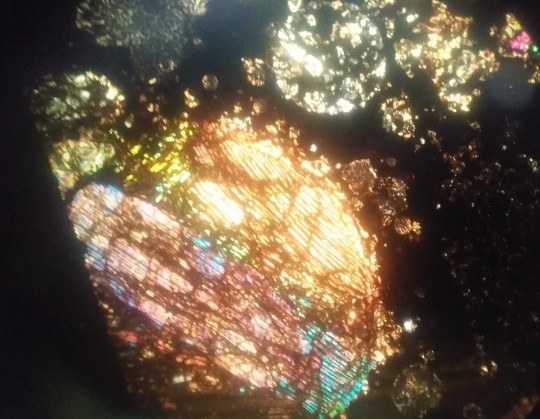
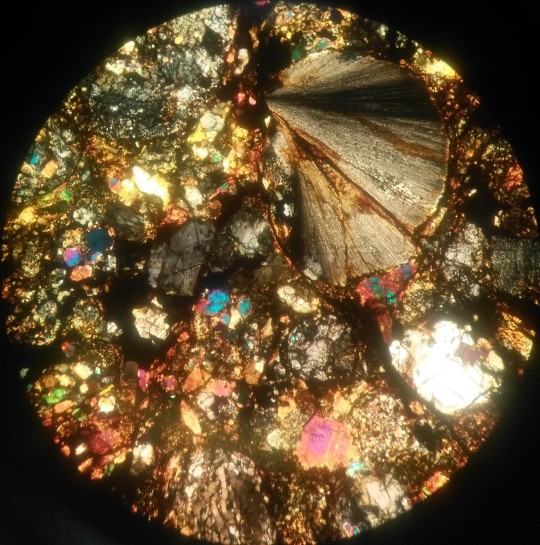

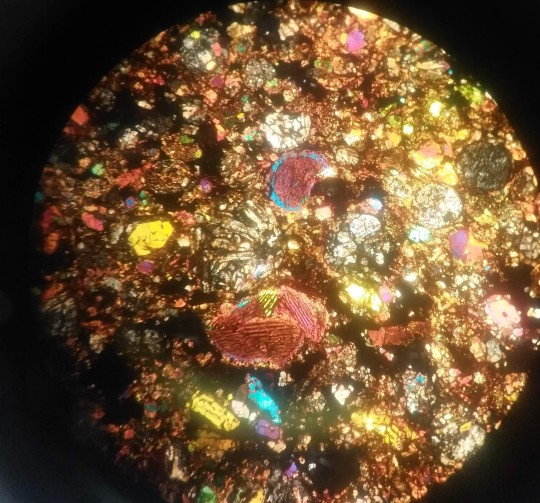
Pics of some chondrite meteorite thin sections under the microscope ft. some of my favorite chondrule types 🥰
#miranda talks#i am not very good at taking pics using the microscope#and these were before i got my phone with the good camera#but still#check out that radial pyroxene chondrule 😍😍😍#ive never gotten a good pic of a barred olivine chondrule but they're still so neat#also if i were to look these up in the official metorite database my name is in there as one of the classifiers!!!#photography#geology#okay to rb if you want
40 notes
·
View notes
Text

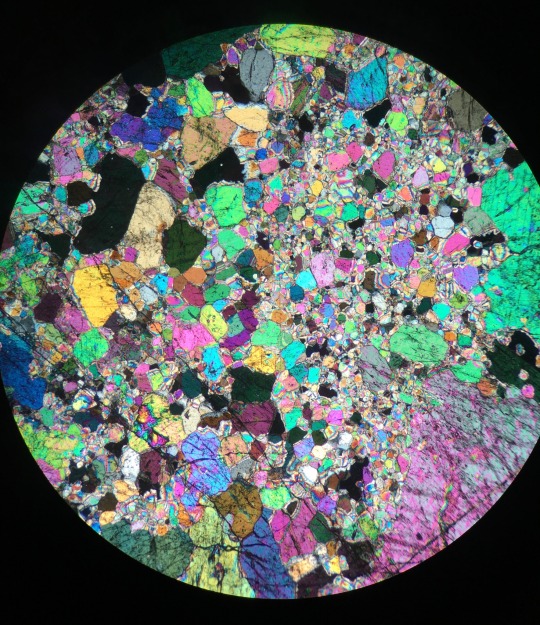
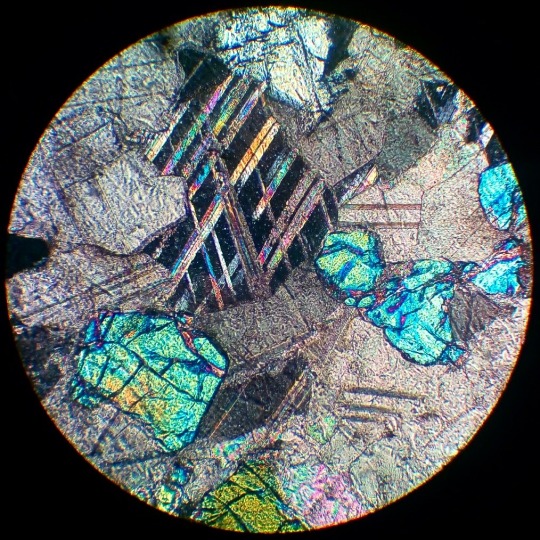

just thought i’d let y’all know olivine is still the best mineral. | to anyone who ever said rocks aren’t cool, you’re wrong | part 1 | part 2
#geology#thin sections#petrology#mineralogy#olivine#also a guest appearance from calcite#serpentine#and pyroxene#surprise porphyritic chondrule too#myedit
70 notes
·
View notes
Photo
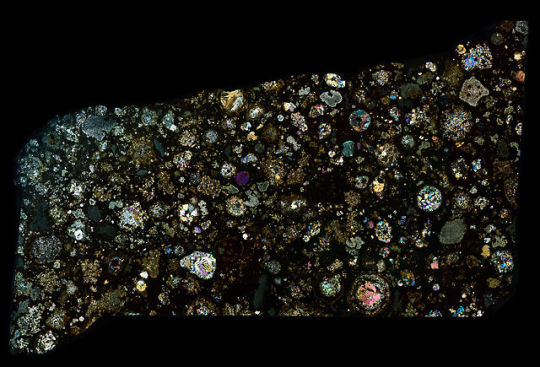
NWA 2224 Meteorite Thin Section
Recommended print size at 300 ppi: 219.0 x 148.8 inches
#meteorite#photomicroscopy#nikonphotography#Photomicrography#Zerene Stacker#carbonaceous#chondrite#chondrule#petrology#geology#astrobiology
2 notes
·
View notes
Text










Why are men
0 notes
Video
vimeo
Views of a “Chondritic Meteorite” in thin section. This is a meteorite that was polished to only about 0.03 millimeters thick, thin enough that light can travel through the rocks. It is then put on a polarizing microscope and polarized light is sent through it. That gives you a chance to see some of the minerals and textures, but there is a second step here. A geologists microscope will have a second polarizer above the sample. That second polarizer can be rotated so that only light that had its direction changed by passing through the mineral reaches the eye of the viewer. This produces an effect called Birefringence, the colors seen in these grains. Birefringence colors can be used along with mineral textures to identify rock types.
This video shows the upper polarizer being rotated, so the light goes from singly-polarized to doubly polarized and colors appear as they do it.
The spherical blobs in this sample are the chondrules. They are thought to have been blobs of rapidly melted, rapidly cooled rock that floated out in space. Eventually they were assembled into rocks on some of the early asteroids.
#Geology#Chondrule#Thin section#ThinSectionThursday#science#Geologist#video#Polarized#Light#meteorite#asteroid#Chondritic meteorite#The earth story
76 notes
·
View notes
Text
msɪgkkɛuwɪəəvmɛlʃdrə
Pronounced: msigkkayuwiuhuhvmaylshdruh.
Pantheon of: communication, inaccuracy, amenability, objectivity, path, plant material.
Entities
Nəəʊptɪnzkɪɛbaɪssədɛɪ
Pronounced: nuhuhooptinzkiaybaissuhdayi
Inaccuracy: looseness.
Communication: signal.
Plant Material: cork.
Path: main line.
Legends: game of chance, demonstration.
Prophecies: finger-roll, convergence.
Relations: sæəəbdnɛvtʃnɒmrzddʒlzk (direct loan), ɪfsdzɪðnzdɒskmknʌiaɪə (marking ink), əyəɪdəərnurtmlnɒydmn (sticky end).
Sæəəbdnɛvtʃnɒmrzddʒlzk
Pronounced: sauhuhbdnayvtshnoumrzdjlzk
Inaccuracy: looseness.
Communication: language.
Plant Material: vegetable tallow.
Path: fairway.
Legends: premiership, badminton.
Prophecies: multiple voting, slalom, curse, hemorrhagic stroke.
Relations: ɪfsdzɪðnzdɒskmknʌiaɪə (methionine), nəəʊptɪnzkɪɛbaɪssədɛɪ (wine).
Əyəɪdəərnurtmlnɒydmn
Pronounced: uhyuhiduhuhrnurtmlnouydmn
Inaccuracy: inexactness.
Communication: document.
Plant Material: plant product.
Path: line of fire.
Legends: pornography.
Prophecies: dark ground illumination.
Relations: ɪfsdzɪðnzdɒskmknʌiaɪə (protease), sæəəbdnɛvtʃnɒmrzddʒlzk (residual soil), nəəʊptɪnzkɪɛbaɪssədɛɪ (erythropoietin).
Ɪfsdzɪðnzdɒskmknʌiaɪə
Pronounced: ifsdzithnzdouskmknuiaiuh
Inaccuracy: looseness.
Communication: psychic communication.
Plant Material: wood.
Path: air lane.
Legends: engine failure, slam dancing, dumping, destabilization, intrusion.
Prophecies: genetic screening, cross country, guardianship.
Relations: sæəəbdnɛvtʃnɒmrzddʒlzk (chondrule).
0 notes
Text
Hi I had my meteorites class today :D

Carbonaceous chondrite, think it was a thin section from the Allende meteorite. This is through cross-polarised light which is why some of it (the olivine!) is a really bright colour.
I apologise that it's a bit blurry, it's difficult to take a picture down a microscope lmao
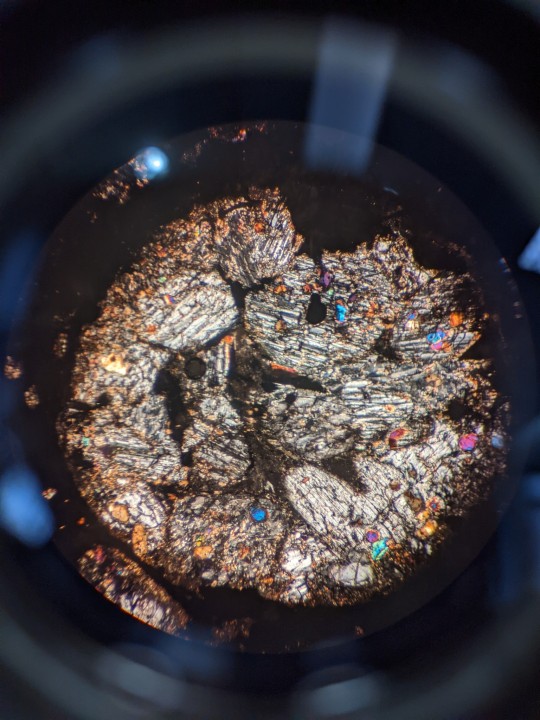
Close up of one of the chondrules from above, this is twinned clinoenstatite (a pyroxene) :D it's very cool and I think you only really find it in chondrites
But the coolest thing about this? This stuff is incredibly old. It's from the very beginning of the solar system, around 4.5 billion years ago. I just think that's so, so amazing.
And, and, the matrix this is in? That black stuff around the chondrules and bigger grains and stuff? That contains presolar grains - that stuff's been around longer than the Solar System. Just wow. I love my course :D
9 notes
·
View notes